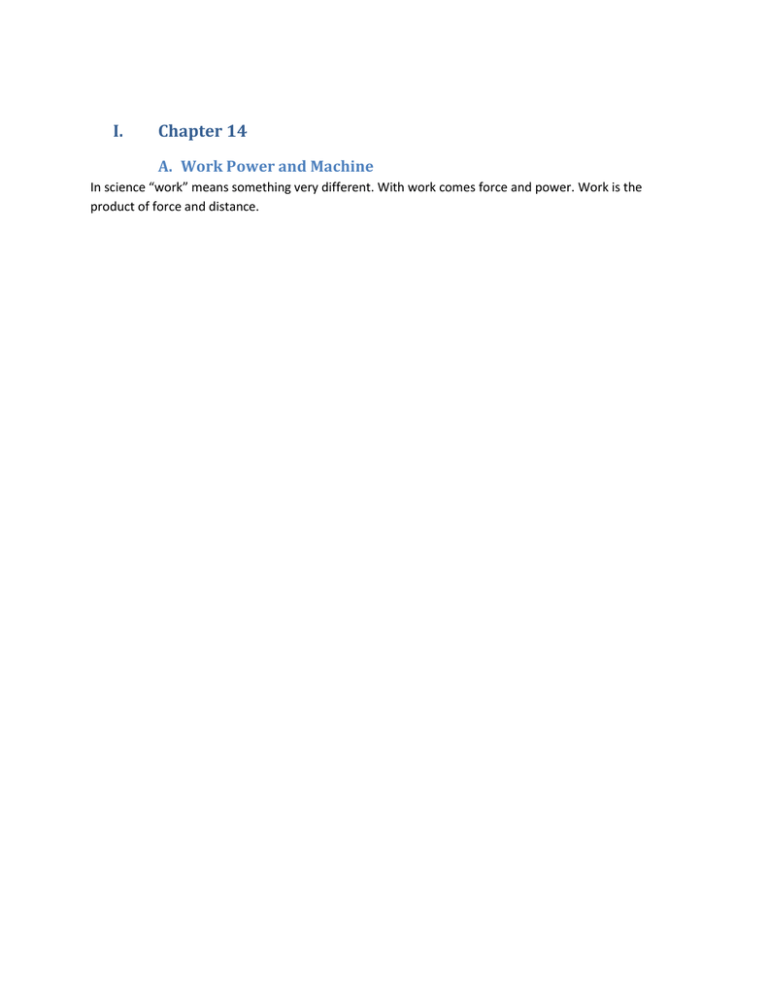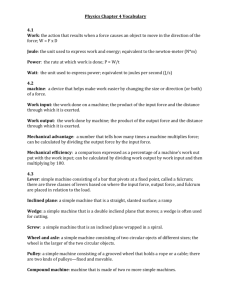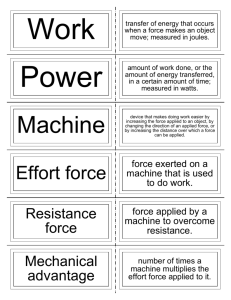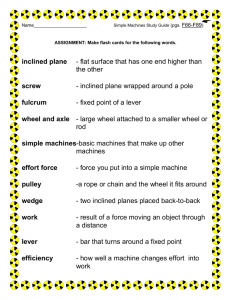In science “work”
advertisement

I. Chapter 14 A. Work Power and Machine In science “work” means something very different. With work comes force and power. Work is the product of force and distance. B. Work and Power 1. What is work? For a force to do work on an object, some of the force must act in the same direction as the object moves. If there is no movement, no work is done a) The product of force and distance b) Work requires motion c) Work depends on direction Any part of a force that does not act in the direction of motion does not work on an object. d) Joule is the SI unit of work. 2. What is Power? Power is the rate of doing work. Doing work at a faster rate requires more power. To increase power, you can increase the amount of work done in a given time, or you can do a given amount of work in less time. a) Power is the rate of doing work b) Power is work divided by time c) A common unit of power is horsepower. d) Horsepower is equal to about 746 watts. C. Work and Machines Machine is a device that changes a force. 1. Machines Do Work Machines make work easier to do. They change the size of the force needed, the direction of a force, or the distance over which a force acts. a) Increasing force A small force exerted over a large distance becomes a large force exerted over a short distance. b) Increasing distance A machine that decreases the distance through which you exert a force increases the amount of force required. c) Changing direction Machines change the amount of force and the distance the force acts through, but thy can also change the direction of the force. 2. Work Input and Work Output a) Input force is the force you exert on a machine b) Input distance is the distance the input force acts through c) Work done by the input force acting through the input distance is work input d) The force exerted by a machine is output force e) The distance the output force is exerted through is output distance f) Output force divided by output distance is work output D. Mechanical Advantage and Efficiency 1. Mechanical Advantage Because of friction, the work done by a machine is always less than the work done o the machine. a) Number of times a machine increases its input force (1) Ideal mechanical advantage (2) Actual mechanical advantage (3) Input distance divided by output distance 2. Efficiency a) Percentage of work input that becomes work output b) Work output divided by work input multiplied by 100% E. Simple Machines 1. Levers To calculate the ideal mechanical advantage of any lever, divide the input arm by the output arm. a) Fulcrum a) The fixed point that the lever rotates around c) Lever b) A rigid bar that is free to move around a fixed point c) Input arm c) The distance between the input force and the fulcrum d) Output arm d) The distance between the output force and the fulcrum e) First- class Lever Depending on the location of the fulcrum, the mechanical advantage of the first class lever e) h) Second- class Lever i) Third- class Lever 2. Wheel and Axle To calculate the ideal mechanical advantage of the wheel and axle, divide the radius where the input force is exerted by the radius where the output force is exerted. a) Radius b) Two disks 3. Inclined Planes The ideal mechanical advantage of an inclined plane is the distance along the inclined plane divided by its change in height. a) Slanted surface a) Forces move and object to a different elevation b) Distance along inclined plane divided by its change in height 4. Wedges and Screws a) Wedges A thin wedge of a given length has a greater mechanical advantage than a thick wedge of the same length a) V- Shaped object whose sides are two inclined planes sloped towards each other b) Thin wedge of a given length c) Knife blade d) Zipper b) Screw Screws with threads that are closer together have a greater ideal mechanical advantage a) Inclined plane wrapped around a cylinder b) Nuts c) bolts








